Abstract
Fournier's gangrene, a rapidly progressive necrotizing fasciitis of the perineum and external genitalia that leads to extensive soft tissue necrosis, remains a medical‐surgical emergency. The authors present a case of coverage of a scrotal loss of substance with testicular exposure by a medial fasciocutaneous flap of the unilateral thigh after debridement and initial medical treatment of Fournier's gangrene in a 50‐year‐old quadriplegic patient. The clinical examination at 8 months showed an aesthetic and functional result. The trophic‐cutaneous thigh flap that the authors propose for frail, elderly, and neurological subjects with low functional requirements allows coverage of the scrotal region with relatively thick skin, color, and texture close to those of the scrotum. It also offers technical simplicity, moderate scarring, and functional remnants at the price of less morbidity.
Keywords: Fournier's gangrene, medial fasciocutaneous flap, necrotizing fasciitis, scrotum reconstruction
Fournier's gangrene remains the most challenging form of necrotizing fasciitis due to its location and poor prognosis. The medial fasciocutaneous flap offers an easy to perform and low‐cost alternative solution for scrotum reconstruction in elder and quadriplegic patients.
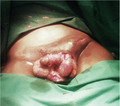
1. INTRODUCTION
Fournier's gangrene as described in the first time by Avicenna and then formalized by Alfred Fournier is a fulminant necrotizing fasciitis of the perineum and the external genital often leading to a rapidly progressing tissue necrosis. 1 , 2 This disease remains a medico surgical emergency with a variable mortality rate according to diverse series, and it is often associated with comorbidities (HIV, diabetes mellitus, and nephropathy). 3 , 4
2. CASE PRESENTATION
We present a 50‐year‐old male patient with no known comorbidity who consulted at our facility with a primary medical history of cervical spine trauma with tetraplegia evolving for 2 years that we admitted for Fournier's Gangrene. The clinical examination shows a patient with appropriate weight and height and a good functional status. Prior to intervention, inflammatory (C‐reactive protein, sedimentation rate) and hematologic (total blood count) screenings were performed. The findings revealed hyperleukocytosis with a high sedimentation rate (SR = 150). There were no imaging or histopatholical examinations performed. A surgical debridement was realized, and a triple antibiotic therapy consisting of clindamycin, metronidazole, and gentamycin implemented. Following the surgical debridement and the initial medical treatment, he presented a high loss of the scrotal tissues leading to testicular exposition (Figures 1, 2 and 3).
FIGURE 1.
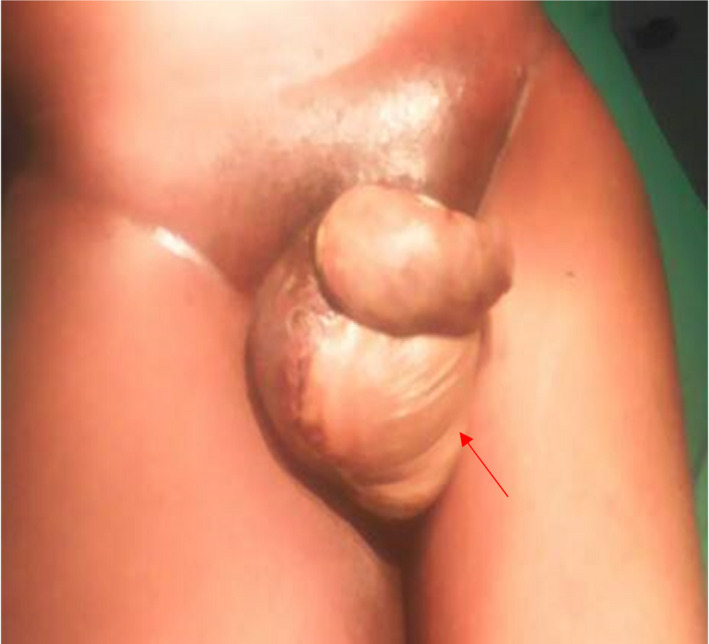
Fifty‐year‐old patient admitted to the OR for surgical debridement of Fournier's gangrene (red arrow)
FIGURE 2.
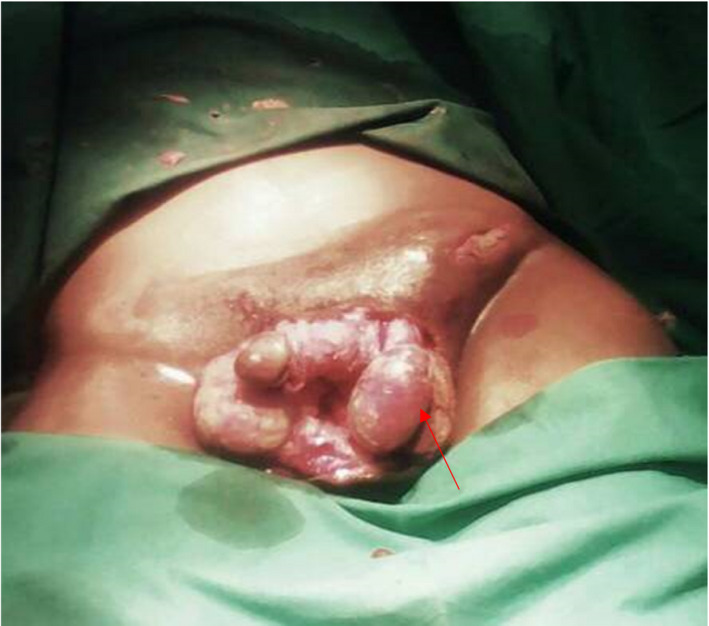
Image after aggressive debridement; large loss of scrotal substance with testicular exposure; local care in the operating room (red arrow)
FIGURE 3.
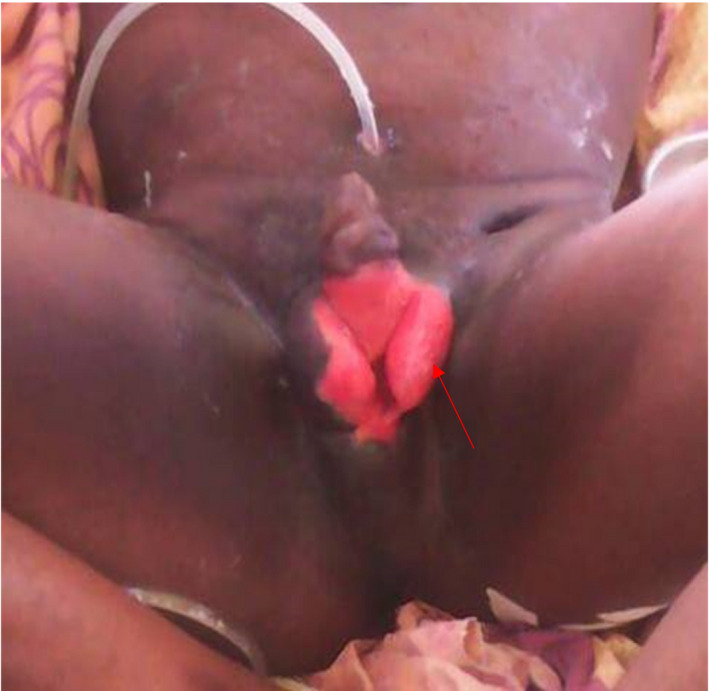
Fifty‐year‐old patient treated for Fournier's gangrene. Extensive scrotal loss of substance with testicular exposure (red arrow)
The unilateral left medial thigh pedunculated Fasciocutaneous flap was used to cover the defect at the 30th day of hospitalization following the normalization of the inflammatory screening results and the resolution of the local and general signs of infection. We drew a 6 × 15 cm unilateral flap on the medial part of the thigh adjacent to the scrotal defect, with a proximal base (toward the area of low venous pressure). The extent of the substance loss, the desired movement (translation, rotation, etc.), and the possibility of immediate closure of the donor area influenced the direction of the flap's large axis. The harvesting was done from distal to proximal, including skin, fat, and superficial fascia.
Because there was no direct communication between the donor and recipient sites, the donor area was closed directly without draining. We were able to move the flap to the perineum by rotation. The presence of a skin bridge between the donor and recipient sites justified a second surgical weaning step on the 21st postoperative day.
After 8 months of follow‐up, the results were judged satisfactory (Figures 4 and 5).
FIGURE 4.
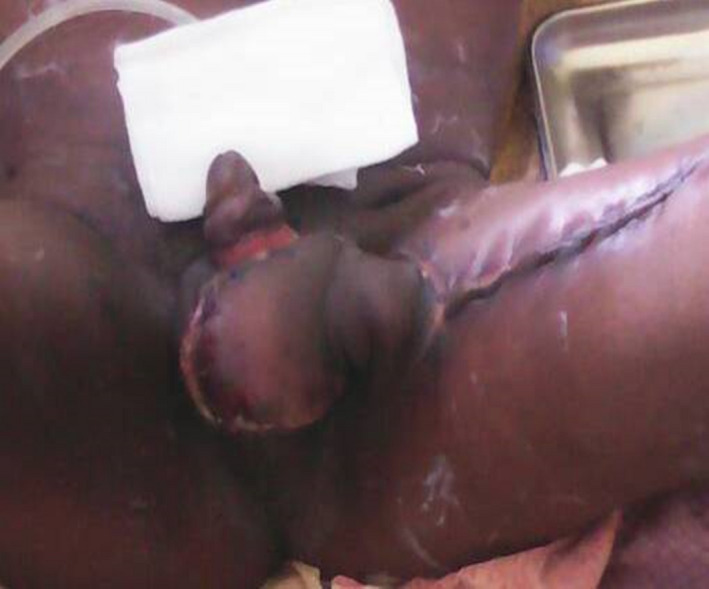
Reconstruction of the scrotum by rotation of the medial fasciocutaneous pedicled flap of the thigh at 30 days of hospitalization
FIGURE 5.
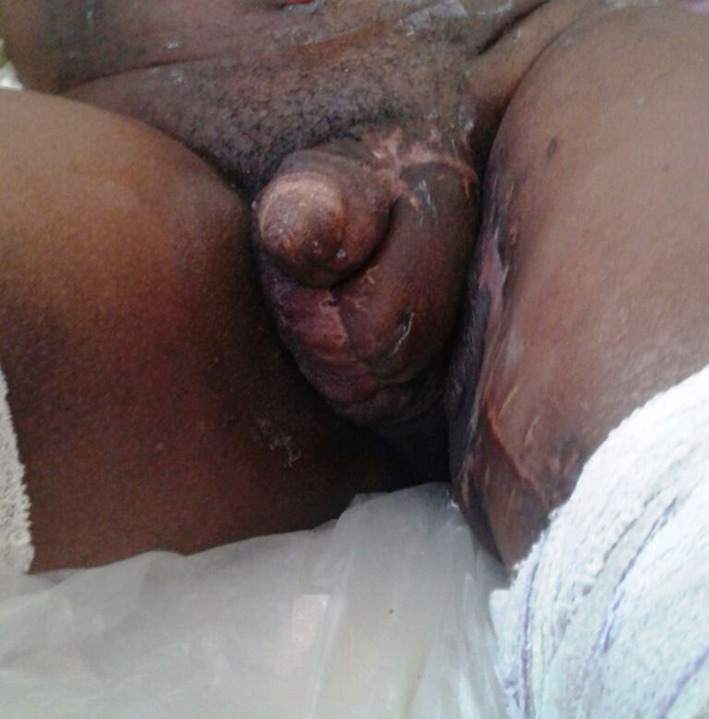
Image of the neoscrotum at 8 months after scrotal reconstruction with medial thigh fasciocutaneous flap
3. DISCUSSION
Fournier's gangrene a rapidly progressive necrotizing fasciitis of the perineum is grieved by a high mortality rate. It is often due to a polymicrobial infection and usually located in the scrotal region. Fournier's gangrene occurs in both male and female patients with a high predominance in male patients (sex ratio: 10/1). The mean age varies from 50.03 ± 11.13 to 50.03 ± 11.13 years according to diverse studies. 2 , 5 Several surgical techniques have been developed to address Fournier's gangrene: debridement on nonviable tissue, total skin graft, musculocutaneous or Fasciocutaneous flaps. 1 , 4 , 5 Some surgeons propose the immersion of the affected testicles in the medial femoral pocket; however, this intervention often leads to spermatic cord necrosis. 6
Other authors advocate the use of mesh skin grafts. However, this results in a cover that is too thin, atrophic, and susceptible to skin maceration and ulceration in the inguinal fold. Furthermore, the testicle is adhered to the perineum by graft scar retraction. Some authors propose using a pedicled musculocutaneous flap, which provides repair tissue that is too thick and useless for the area to be repaired. The surgical trauma is also out of proportion to the area to be rebuilt. 5 , 7 , 8 , 9 , 10 Barham et al. propose the use of the IntegraTM dermal regeneration template with good results. However, it is cost prohibitive in our context where the population is poor and health insurance is nonexistent. 11
Although there is variability in therapeutic approaches, Fournier's gangrene is grieved by high mortality rate. The surgical debridement is the most recommended technique and offers a high success rate. 5 , 8 The surgical debridement remains at our knowledge the golden standard of care. Skin grafts and reconstruction with flaps are applied when large area of tissue is lost and offer interesting results. Other treatments include skin plasty by local tissues, split autodermoplasty, muscle plastic, stem plastic, and combined methods. 6 , 12 Hyperbaric oxygen, vacuum aspiration, and fecal and urinary diversions techniques are others therapeutics modality that help accelerate the healing process. 5 , 7 Often, more than one theater session are required for satisfactory results. 10
Various reconstructive techniques are utilized by different surgeons. This technique includes testis transplantation, free skin graft, axial groin flaps, and myocutaneous flaps. Following a study conducted in India over 11 years reporting 43 cases of Fournier's gangrene, split thickness skin graft seemed to be superior to others techniques tested. 13 , 14 A series by Black et al. reported a 100% graft take for patient with penile skin deficiency following Fournier's gangrene treated with sheets of unmeshed, split thickness skin grafts with satisfactory cosmetic outcome at 6 months follow‐up. 15
The medial fasciocutaneous flap of the thigh is the most proposed by the authors for the fragile, elderly, and neurological subjects with little functional demand. In terms of reproduction, it allows coverage of the scrotal region with the relatively thick skin of color and texture close to that of the scrotum, technical simplicity, modest scarring, and functional remnants at the cost of less morbidity. This technique is preferable to the inguinal flap that uses a relatively thick and sensitive tissue with a poor aesthetic outcome due to the absence of hair and the lighter color of the skin than the scrotal skin. 3 , 4 , 5
4. CONCLUSION
The medial fasciocutaneous thigh flap is a good indication for scrotal reconstruction after Fournier's gangrene in frail, elderly, neurological patients with little functional demand in terms of reproduction.
CONFLICTS OF INTEREST
None.
AUTHOR CONTRIBUTION
RMM and DSN have designed, conceptualized the study, and wrote the first draft under the supervision of JCN. RMM and JCN operated upon the patient. AKM, NBM, FB, AMR, and CBW contributed to the drafting of the paper. All authors have reviewed and approved the final manuscript.
ETHICAL APPROVAL
This case report received ethical clearance from the Ethical Committee of the Official University of Bukavu.
CONSENT
A written informed consent was signed by the patient prior to publication of this paper.
ACKNOWLEDGEMENTS
None.
Mwenibamba RM, Nteranya DS, Mukakala AK, et al. Medial thigh fasciocutaneous flaps for reconstruction of the scrotum following Fournier gangrene: A case report. Clin Case Rep. 2022;10:e05747. doi: 10.1002/ccr3.5747
Funding information
None
DATA AVAILABILITY STATEMENT
All the materials used in this study are available on request.
REFERENCES
- 1. El‐Qushayri AE, Khalaf KM, Dahy A, et al. Fournier’s gangrene mortality: a 17‐year systematic review and meta‐analysis. Int J Infect Dis. 2020;92:218‑225. https://www.ijidonline.com/article/S1201‐9712(19)30503‐X/abstract. Accessed August 27, 2021. [DOI] [PubMed] [Google Scholar]
- 2. Taken K, Oncü MR, Ergun M, et al. Fournier’s gangrene: causes, presentation and survival of sixty‐five patients. Pak J Med Sci. 2016;32(3):746‐750. http://pjms.com.pk/index.php/pjms/article/view/9798. Accessed August 27, 2021. [DOI] [PMC free article] [PubMed] [Google Scholar]
- 3. Zhang N, Yu X, Zhang K, Liu T. A retrospective case series of Fournier’s gangrene: necrotizing fasciitis in perineum and perianal region. BMC Surg. 2020;20(1):259. https://bmcsurg.biomedcentral.com/articles/. Accessed August 27, 2021. [DOI] [PMC free article] [PubMed] [Google Scholar]
- 4. Chalya PL, Igenge JZ, Mabula JB, Simbila S. Fournier’s gangrene at a tertiary health facility in northwestern Tanzania: a single centre experiences with 84 patients. BMC Res Notes. 2015;8(1):481. http://www.biomedcentral.com/1756‐0500/8/481. Accessed August 27, 2021. [DOI] [PMC free article] [PubMed] [Google Scholar]
- 5. Sockkalingam VS, Subburayan E, Velu E, Rajashekar ST, Swamy AM. Fournier’s gangrene: prospective study of 34 patients in South Indian population and treatment strategies. Pan Afr Med J. 2018;31:110. http://www.panafrican‐med‐journal.com/content/article/31/110/full/. Accessed February 21, 2022. [DOI] [PMC free article] [PubMed] [Google Scholar]
- 6. Chernyadyev SA, Ufimtseva MA, Vishnevskaya IF, et al. Fournier’s gangrene: literature review and clinical cases. Urol Int. 2018;101(1):91‑97. https://www.karger.com/Article/FullText/490108. Accessed February 21, 2022. [DOI] [PMC free article] [PubMed] [Google Scholar]
- 7. AlShehri YA, AlBurshaid H, AlBassam L, AlMutairi K. Management of Fournier’s gangrene with skin grafting by bagging technique of testes: case report. GMS Interdiscip Plast Reconstr Surg DGPW. 2019;8:Doc02. https://www.ncbi.nlm.nih.gov/pmc/articles/PMC6379833/. Accessed February 27, 2022. [DOI] [PMC free article] [PubMed] [Google Scholar]
- 8. Hagedorn JC, Wessells H. A contemporary update on Fournier’s gangrene. Nat Rev Urol. 2017;14(4):205‑214. http://www.nature.com/articles/nrurol.2016.243. Accessed February 21, 2022. [DOI] [PubMed] [Google Scholar]
- 9. Insua‐Pereira I, Ferreira PC, Teixeira S, Barreiro D, Silva Á. Fournier’s gangrene: a review of reconstructive options. Cent Eur J Urol. 2020;73(1):74‑79. https://www.ncbi.nlm.nih.gov/pmc/articles/PMC7203772/. Accessed February 27, 2022. [DOI] [PMC free article] [PubMed] [Google Scholar]
- 10. Nnabugwu II, Onumaegbu OO, Okolie LT. Fournier’s gangrene: a retrospective review of management outcomes and seasonal variations of clinical presentation. Afr J Urol. 2021;27(1):66. https://afju.springeropen.com/articles/. Accessed February 21, 2022. [Google Scholar]
- 11. Barham DW, Lee MY, Stackhouse DA. Novel scrotal reconstruction after Fournier’s gangrene using the IntegraTM dermal regeneration template. Urology. 2019;128:e3‑e4. https://linkinghub.elsevier.com/retrieve/pii/S0090429519302134. Accessed February 21, 2022. [DOI] [PubMed] [Google Scholar]
- 12. Zhang N, Yu X, Zhang K, Liu T. A retrospective case series of Fournier’s gangrene: necrotizing fasciitis in perineum and perianal region. BMC Surg. 2020;20(1):259. https://bmcsurg.biomedcentral.com/articles/. Accessed February 21, 2022. [DOI] [PMC free article] [PubMed] [Google Scholar]
- 13. Mallikarjuna MN, Vijayakumar A, Patil VS, Shivswamy BS. Fournier’s gangrene: current practices. ISRN Surg. 2012;2012:942437. https://www.ncbi.nlm.nih.gov/pmc/articles/PMC3518952/. Accessed April 1, 2022. [DOI] [PMC free article] [PubMed] [Google Scholar]
- 14. Parkash S, Gajendran V. Surgical reconstruction of the sequelae of penile and scrotal gangrene: a plea for simplicity. Br J Plast Surg. 1984;37(3):354‑357. https://linkinghub.elsevier.com/retrieve/pii/000712268490078X. Accessed April 1, 2022. [DOI] [PubMed] [Google Scholar]
- 15. Black PC, Friedrich JB, Engrav LH, Wessells H. Meshed unexpanded split‐thickness skin grafting for reconstruction of penile skin loss. J Urol. 2004;172(3):976‑979. http://www.jurology.com/. Accessed April 1, 2022. [DOI] [PubMed] [Google Scholar]
Associated Data
This section collects any data citations, data availability statements, or supplementary materials included in this article.
Data Availability Statement
All the materials used in this study are available on request.


